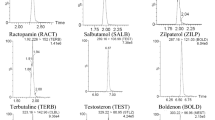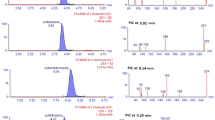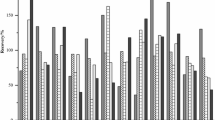Abstract
A preliminary screening assay based on a microbial chromogenic reaction was developed to detect common antibiotic residues in meat rapidly. The assay comprised two bioassays: one for Escherichia coli and another for Geobacillus stearothermophilus. The assay was optimized and evaluated for the simultaneous screening of 30 antibiotics from five common antibiotic classes (tetracyclines, aminoglycosides, macrolides, β-lactams, and quinolones) found in meat. Extraction using phosphate-acetonitrile buffer (pH 7.2) and a delipidating treatment using n-hexane resulted in a high extraction efficacy for the five antibiotics, without affecting the microbial color reaction. A carrier, polyvinyl alcohol (0.1 g/mL); a cross-linking agent, boric acid-sodium tetraborate solution (pH 5.5); and a bacterial suspension with an initial optical density of 1.0 were the optimal embedding conditions for stability, microbial activity, and chromogenic efficiency. The assay exhibited a 6-month shelf life, with detection limits of 40–60, 60–140, 60–100, 20–40, and 40–180 μg/kg for tetracyclines, aminoglycosides, macrolides, β-lactams, and quinolones, respectively, which met the European Commission (37/2010) requirements for antibiotic residue limits. Our assay results were confirmed using LC-MS/MS with 160 samples, revealing a good correlation. This study demonstrates a reliable, easy-to-use, and economical method for preliminary screening of antibiotic residues in meat. This method may find an immediate application in food safety and general testing laboratories.




Similar content being viewed by others
Data Availability
The data produced and/or analyzed in the current study are available from the corresponding author on reasonable request.
References
Zhu, H. (2016). Hazards of antibiotic residues in animal-derived foods and detection methods. Industrial & Science Tribune, 15, 64–65.
Jank, L., Martins, M. T., Arsand, J. B., Motta, T. M. C., Feijó, T. C., dos Santos Castilhos, T., & Pizzolato, T. M. (2017). Liquid chromatography–tandem mass spectrometry multiclass method for 46 antibiotics residues in milk and meat: development and validation. Food Analytical Methods, 10(7), 2152–2164. https://doi.org/10.1007/s12161-016-0755-4.
Li, B., & Ji, Z. (2019). Main detection techniques and coping strategies for antibiotic residues in animal products. Poultry Science, 2, 53–55.
Zheng, Y., Fan, L., & Dong, Y. (2019). Detection technology for veterinary antibiotic residue in livestock and poultry products: a review. Quality and Safety of Agro-products, 3, 65–69.
Chen, X., & Ye, N. (2016). Graphene oxide-reinforced hollow fiber solid-phase microextraction coupled with high-performance liquid chromatography for the determination of cephalosporins in milk samples. Food Analytical Methods, 9(9), 2452–2462. https://doi.org/10.1007/s12161-016-0435-4.
Ramatla, T., Ngoma, L., Adetunji, M., & Mwanza, M. (2017). Evaluation of antibiotic residues in raw meat using different analytical methods. Antibiotics, 6(4), 34. https://doi.org/10.3390/antibiotics6040034.
Hennart, S. L. A., & Faragher, J. (2012). Validation of the Delvotest® SP NT. Journal of AOAC International, 95(6), 1807–1815. https://doi.org/10.5740/jaoacint.12-232.
Nagel, O., Molina, M., & Althaus, R. (2013). Use of chemometric techniques to design a microbiological method for sulfonamide detection in milk. Czechoslovak Journal of Food Sciences, 31(6), 627–632.
Karageorgou, E., Christoforidou, S., Ioannidou, M., Psomas, E., & Samouris, G. (2018). Detection of β-lactams and chloramphenicol residues in raw milk-development and application of an HPLC-DAD method in comparison with microbial inhibition assays. Foods, 7(6), 82. https://doi.org/10.3390/foods7060082.
Wu, Q., Peng, D., Liu, Q., Shabbir, M. A. B., Sajid, A., Liu, Z., & Yuan, Z. (2019). A novel microbiological method in microtiter plates for screening seven kinds of widely used antibiotics residues in milk, chicken egg and honey. Frontiers in Microbiology, 10, 436. https://doi.org/10.3389/fmicb.2019.00436.
Zhu, J. (2018). Application and analysis of antibiotic in milk by microbial chromogenic assay. China Food Safety Magazine, 21, 66–67.
Lee, D. D., Lee, E. Y., Jeong, S. H., & Chang, C. L. (2007). Evaluation of a colorimetric broth microdilution method for antimicrobial susceptibility testing using 2,3,5-triphenyltetrazolium chloride. Korean Journal of Clinical Microbiology, 10(1), 49–53.
Tumini, M., Nagel, O. G., Molina, P., & Althaus, R. L. (2016). Novel bioassay using Bacillus megaterium to detect tetracycline in milk. Revista Argentina de Microbiología, 48(2), 143–146. https://doi.org/10.1016/j.ram.2016.02.001.
Huang, X., Zheng, J., Wu, Q., Chen, B., & Tang, M. (2008). Study on MIA method for determination of antibiotics residues in food. Food Science, 28(8), 418–421.
Hu, K., Li, Y., Zhu, Z., Huan, X., Wang, M., Fang, S., & Yang, X. (2009). A rapid method to determine the residues of enrofloxacin in fishery products by microbiological chromotest. Journal of Shanghai Ocean University, 18(4), 472–478.
Wei, G. (2018). Residue analysis of β-lactams antibiotics drugs in animal derived food by microbiological inhibition assay. The Light & Textile Industries of Fujian, 4, 40–42.
Wang, L., Si, X., & Tang, H. (2019). Residue detection of seven antibiotics in livestock and poultry meat. Chinese Journal of Analytical Chemistry, 15, 1–5.
Jammoul, A., & El Darra, N. (2019). Evaluation of antibiotics residues in chicken meat samples in Lebanon. Antibiotics, 8(2), 69. https://doi.org/10.3390/antibiotics8020069.
Benavides, S., Cortés, P., Parada, J., & Franco, W. (2016). Development of alginate microspheres containing thyme essential oil using ionic gelation. Food Chemistry, 204, 77–83. https://doi.org/10.1016/j.foodchem.2016.02.104.
Lui, Y., Miao, Y., & Wang, J. (2016). PVA immobilized microorganism method and application. Science and Technology Review, 34, 56–61.
Deng, Y., Huo, A., & Li, S. (2018). Process optimization, characterization, and functional properties analysis of Bifidobacterium composite microcapsules. Science and Technology of Food Industry, 10, 23–24.
Index of Veterinary Drugs | CODEX ALIMENTARIUS FAO-WHO. (n.d.). Available from: http://www.fao.org/fao-who-codexalimentarius/codex-texts/dbs/vetdrugs/veterinary-drugs/en/. Accessed June 24, 2020.
Tumini, M., Nagel, O. G., & Althaus, R. L. (2019). Five-assay microbiological system for the screening of antibiotic residues. Revista Argentina de Microbiología, 51(4), 345–353. https://doi.org/10.1016/j.ram.2019.01.002.
Sanz, D., Mata, L., Condón, S., Sanz, M. Á., & Razquin, P. (2011). Performance of a new microbial test for quinolone residues in muscle. Food Analytical Methods, 4(2), 212–220. https://doi.org/10.1007/s12161-010-9151-7.
Mata, L., Sanz, D., & Razquin, P. (2014). Validation of the Explorer ® 2.0 test coupled to e-Reader ® for the screening of antimicrobials in muscle from different animal species. Food Additives and Contaminants A, 31(9), 1496–1505. https://doi.org/10.1080/19440049.2014.934303.
Schneider, M. J., & Lehotay, S. J. (2008). A comparison of the FAST, Premi® and KISTM tests for screening antibiotic residues in beef kidney juice and serum. Analytical and Bioanalytical Chemistry, 390(7), 1775–1779. https://doi.org/10.1007/s00216-008-1918-y.
Wang, Y., Li, Y., & Yan, G. (2016). Advances in antibiotic residues pre-treatment and determination method. Shandong Industrial Technology, 20, 292–293.
Zhang, P., Shen, Z., & Zhang, Y. (2018). Drug resistance characteristics and epidemiological analysis of 8 isolates of NDM-1-producing Enterobacteriaceae. Laboratory Medicine, 33, 616–621.
Bohn, T., Pellet, T., Boscher, A., & Hoffmann, L. (2013). Developing a microbiological growth inhibition screening assay for the detection of 27 veterinary drugs from 13 different classes in animal feeding stuffs. Food Additives and Contaminants A, 30(11), 1870–1887. https://doi.org/10.1080/19440049.2013.832400.
Martins, E., Poncelet, D., & Renard, D. (2017). A novel method of oil encapsulation in core-shell alginate microcapsules by dispersion-inverse gelation technique. Reactive and Functional Polymers, 114, 49–57. https://doi.org/10.1016/j.reactfunctpolym.2017.03.006.
Lin, J., & Jin, H. (2015). Experiment on rural domestic wastewater treatment by PVA immobilized microorganism and bamboo charcoal. Guangzhou Chemical Industry, 40, 104–105.
Funding
This work was supported by the National Key R&D Program of China (grant number 2018YFC1603400).
Author information
Authors and Affiliations
Contributions
The study was conceived and designed by Shou-wei Wang, Wen-ping Guo, and Ying-ying Li. The first draft of the manuscript was written by Wei Fan. Statistical analyses were performed by Wei Fan and Xiao-yue Gao. Sections of the manuscript were written by Wei Fan, He-nan Li, and Ming-wu Zang. All authors read and approved the final manuscript.
Corresponding author
Ethics declarations
Conflict of Interest
The authors declare that they have no conflict of interest.
Ethics Approval and Informed Consent
Not applicable.
Consent to Participate
Not applicable.
Consent for Publication
Not applicable.
Code Availability
Not applicable.
Additional information
Publisher’s Note
Springer Nature remains neutral with regard to jurisdictional claims in published maps and institutional affiliations.
Rights and permissions
About this article
Cite this article
Fan, W., Gao, Xy., Zang, Mw. et al. Development and Evaluation of a Preliminary Screening Assay for Antibiotic Residues in Meat. Appl Biochem Biotechnol 193, 1129–1146 (2021). https://doi.org/10.1007/s12010-020-03462-z
Received:
Accepted:
Published:
Issue Date:
DOI: https://doi.org/10.1007/s12010-020-03462-z




